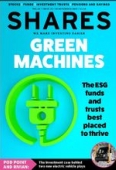Archived article
Please note that tax, investment, pension and ISA rules can change and the information and any views contained in this article may now be inaccurate.
Does Wall Street fail the Gordon Gekko test?

Gordon Gekko, the insider-trading corporate raider of 1987’s Oliver Stone film Wall Street, may have been a villain but that did not stop him talking a degree of sense. Quite what he would have made of Rivian’s $100 billion-plus market value after its first day of trading we will never know, but we can probably guess, given his comment that: ‘The mother of all evil is speculation.’
After all, that price tag values Rivian more highly than rival (and backer) Ford, even though Ford is forecast by analysts to generate more than $120 billion in sales and $6 billion in net profits. By contrast, Rivian is going to be in loss this year, not least as it only began to ship its first vehicles in September.
Whatever you think of Rivian’s potential, its valuation now prices in an awful lot of good news and not much bad. This is not to say anything bad will happen. But if it does, well, watch out as the valuation offers little or no downside protection.
By contrast, investors can protect their downside, and leave scope for upside, by looking at assets which may be out of favour and could therefore be undervalued as a result. The danger is that something is underperforming and cheap for a perfectly good reason, so careful research is needed. But one trend which catches this author’s eye is the 10-year underperformance of emerging equity markets relative to developed ones.
CLEAR TREND
This can be seen by simply dividing the value of the FTSE Emerging index by that of the FTSE Developed index. If the line rises, emerging markets are outperforming and if it falls then developed arenas are doing better.

Developed markets ended the 1990s on a high as the Asian and Russian currency and debt crises hammered emerging markets, only for them to recover just in time for the technology bubble bust to hobble the developed ones for the best part of a decade. It has been one-way traffic since 2010, however, as developed markets have proved to be the better portfolio pick by far.
The questions to ask now, therefore are ‘why?’ and ‘what could change’?
One good guess as to the reason for the performance disparity would be the sector mix of the indices. But they are not as different as you might think. There is a similar representation in technology and the percentage weighting toward cyclical sectors such as financials, industrials and consumer discretionary. Emerging markets’ greater weighting toward financials in a margin-crushing, zero-interest-rate environment may not help, and nor may the higher weighting toward energy and basic materials (mining) during a low-growth, low-inflation decade, but neither looks conclusive.
NEW YORK, NEW YORK
A more convincing explanation comes in the form of geographic exposures. The runaway US equity market represents two-thirds of developed market capitalisation and China more than one third of emerging markets.




This is not the only reason – China’s weightings have increased over time as overseas listings and the domestically-traded stocks have entered global indices – but the S&P 500 is up by more than 300% since January 2010 and the Shanghai Composite by just 7%.
After a long and loud clamour for their inclusion, index compilers are now busily excluding Chinese stocks owing to US sanctions, governance issues and more besides. That may appeal to contrarians, who will also baulk at the valuation attributed to US stocks.
The Case-Shiller cyclically adjusted price earnings ratio – also known as CAPE – is no use at all as a near-term timing tool. But the two previous occasions when the CAPE exceeded 30 times, and the four prior times when 10-year historic compound returns from the S&P 500 have exceeded double-digits in percentage terms, have all seen the next decade’s returns from US equities tail off very badly indeed.
FRIEND OR FOE
Some investors will be happy to stick to the maxim that ‘the trend is your friend’ and row in with the US and developed markets over China and their emerging counterparts. Others will keep the combination of Gekko and Shiller’s CAPE in mind.
China is trying to support its economy while managing a huge debt mountain and attempting to stop financial speculation from derailing its economy through poor capital allocation. But you can argue the US faces the same challenge, even if it comes with far superior corporate governance and investor protection.
China is acting and could be running monetary policy that is too tight as a result. That leaves it room to loosen. The Federal Reserve might just be ducking the challenge and running policy that is too loose, with the result it will have to tighten in time whether it likes it or not in a reversal of fortune that could, one day, break a 10-year-plus trend in relative share price performance.
Important information:
These articles are provided by Shares magazine which is published by AJ Bell Media, a part of AJ Bell. Shares is not written by AJ Bell.
Shares is provided for your general information and use and is not a personal recommendation to invest. It is not intended to be relied upon by you in making or not making any investment decisions. The investments referred to in these articles will not be suitable for all investors. If in doubt please seek appropriate independent financial advice.
Investors acting on the information in these articles do so at their own risk and AJ Bell Media and its staff do not accept liability for losses suffered by investors as a result of their investment decisions.

 magazine
magazine








